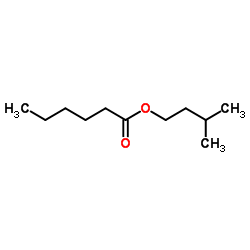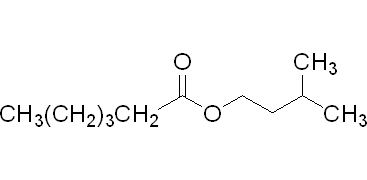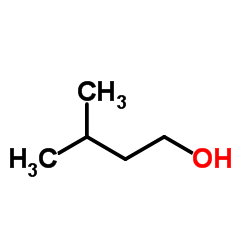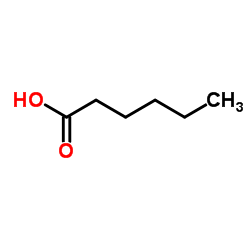己酸异戊酯,Isoamyl Hexanoate,98%
产品编号:Bellancom-198002| CAS NO:2198-61-0| MDL NO:MFCD00027280| 分子式:C11H22O2| 分子量:186.29
本网站销售的所有产品仅用于工业应用或者科学研究等非医疗目的,不可用于人类或动物的临床诊断或者治疗,非药用,非食用,
| 产品名称 | 己酸异戊酯 |
|---|---|
| 英文名称 | Isoamyl Hexanoate,98% |
| CAS编号 | 2198-61-0 |
| 产品熔点 | 250 - 251ºC |
| 产品沸点 | 225.5±0.0 °C at 760 mmHg |
| 产品密度 | 0.9±0.1 g/cm3 |
| 产品闪点 | 82.9±8.3 °C |
| 精确质量 | 186.161987 |
| PSA | 26.30000 |
| LogP | 4.24 |
| 外观性状 | 黑色粉末 |
| 蒸气压 | 0.1±0.4 mmHg at 25°C |
| 折射率 | 1.425 |
相关文档
化学品安全说明书(MSDS)
下载MSDS质检证书(COA)
相关产品
| WGK德国 | 2 |
|---|---|
| RTECS号 | MO8389300 |
| 包装等级 | III |
| 海关编码 | 29349990 |
|
Section I.Chemical Product and Company Identification Chemical Name n-Caproic Acid Isoamyl Ester Portland OR SynonymIso-amyl n-Caproate CH3(CH2)4COO(CH2)2CH(CH3)2 Chemical Formula CAS Number2198-61-0
Section II.Composition and Information on Ingredients Chemical NameCAS Number Percent (%)TLV/PELToxicology Data n-Caproic Acid Isoamyl Ester2198-61-0---------- Not available.Rabbit LD50 (dermal) >5000mg/kg Rat LD50 (oral) >5000mg/kg Section III. Hazards Identification Acute Health EffectsNo specific information is available in our data base regarding the toxic effects of this material for humans. However, exposure to any chemical should be kept to a minimum. Skin and eye contact may result in irritation. May be harmful if inhaled or ingested. Always follow safe industrial hygiene practices and wear proper protective equipment when handling this compound. Chronic Health EffectsCARCINOGENIC EFFECTS : Not available. MUTAGENIC EFFECTS : Not available. TERATOGENIC EFFECTS : Not available. DEVELOPMENTAL TOXICITY: Not available. Repeated exposure to an highly toxic material may produce general deterioration of health by an accumulation in one or many human organs. Section IV.First Aid Measures Eye Contact Check for and remove any contact lenses. IMMEDIATELY flush eyes with runing water for at least 15 minutes. keeping eyelids open. COLD water may be used. DO NOT use an eye oitment. Flush eyes with running water for a minimum of 15 minutes, occasionally lifting the upper eyelids. Seek medical attention. Treat symptomatically and supportively. Skin ContactAfter contact with skin, wash immediately with plenty of water. Gently and thorough wash the contaminated skin with running water and non-abrasive soap. Be particularly careful to clean folds, crevices, creases and groin. COLD water may be used. Cover the irritated skin with an emollient. Seek medical attention. Treat symptomatically and supportively. Wash any contaminated clothing before reusing. InhalationIf the victim is not breathing, perform artificial respiration. Loosen tight clothing such as a collar, tie, belt or waistband. If breathing is difficult, oxygen can be administered. Seek medical attention. Treat symptomatically and supportively. IngestionINDUCE VOMITING by sticking finger in throat. Lower the head so that the vomit will not reenter the mouth and throat. Loosen tight clothing such as a collar, tie, belt, or waistband. If the victim is not breathing, administer artificial respiration. Examine the lips and mouth to ascertain whether the tissues are damaged, a possible indication that the toxic material was ingested; the absence of such signs, however, is not conclusive. Seek immediate medical attention and, if possible, show the chemical label. Treat symptomatically and supportively. Section V. Fire and Explosion Data Not available. FlammabilityCombustible.Auto-Ignition Flash PointsFlammable Limits 85°C (185°F).Not available. Combustion Products These products are toxic carbon oxides (CO, CO 2). Fire Hazards No specific information is available regarding the flammability of this compound in the presence of various materials. Explosion HazardsRisks of explosion of the product in presence of mechanical impact: Not available. Risks of explosion of the product in presence of static discharge: Not available. No additional information is available regarding the risks of explosion. Fire Fighting Media SMALL FIRE: Use DRY chemicals, CO 2, water spray or foam. and InstructionsLARGE FIRE: Use water spray, fog or foam. DO NOT use water jet. Continued on Next Page n-Caproic Acid Isoamyl Ester Section VI.Accidental Release Measures Spill CleanupCombustible material. InstructionsKeep away from heat and sources of ignition. Mechanical exhaust required. Stop leak if without risk. Finish cleaning the spill by rinsing any contaminated surfaces with copious amounts of water. Consult federal, state, and/or local authorities for assistance on disposal. Section VII. Handling and Storage Handling and StorageCOMBUSTIBLE. Handle with caution and minimize exposure. Keep away from heat and sources of ignition. Mechanical exhaust required. Avoid excessive heat and light. DO NOT ingest. Do not breathe gas, fumes, vapor or spray. Wear Information suitable protective clothing. If ingested, seek medical advice immediately and show the container or the label. Treat symptomatically and supportively. Always store away from incompatible compounds such as oxidizing agents. Section VIII. Exposure Controls/Personal Protection Engineering ControlsProvide exhaust ventilation or other engineering controls to keep the airborne concentrations of vapors below their respective threshold limit value. Ensure that eyewash station and safety shower is proximal to the work-station location. Personal ProtectionSplash goggles. Lab coat. Dust respirator. Boots. Gloves. Suggested protective clothing might not be sufficient; consult a specialist BEFORE handling this product. Exposure LimitsNot available. Section IX. Physical and Chemical Properties Physical state @ 20°CColorless liquid.Solubility Not available. 0.86 Specific Gravity Molecular WeightPartition Coefficient 186.29Not available. Boiling PointVapor Pressure 222°C (431.6°F)Not available. Melting PointNot available.Vapor DensityNot available. Refractive IndexNot available.VolatilityNot available. Critical TemperatureNot available.OdorNot available. ViscosityNot available.TasteNot available. Section X.Stability and Reactivity Data Stability This material is stable if stored under proper conditions. (See Section VII for instructions) Conditions of Instability Avoid excessive heat and light. Incompatibilities Reactive with strong oxidizing agents. Section XI. Toxicological Information RTECS NumberMO8389300 Routes of ExposureEye contact. Ingestion. Inhalation. Toxicity DataRabbit LD50 (dermal) >5000mg/kg Rat LD50 (oral) >5000mg/kg Chronic Toxic EffectsCARCINOGENIC EFFECTS : Not available. MUTAGENIC EFFECTS : Not available. TERATOGENIC EFFECTS : Not available. DEVELOPMENTAL TOXICITY: Not available. Repeated exposure to an highly toxic material may produce general deterioration of health by an accumulation in one or many human organs. Acute Toxic EffectsNo specific information is available in our data base regarding the toxic effects of this material for humans. However, exposure to any chemical should be kept to a minimum. Skin and eye contact may result in irritation. May be harmful if inhaled or ingested. Always follow safe industrial hygiene practices and wear proper protective equipment when handling this compound. Continued on Next Page n-Caproic Acid Isoamyl Ester Section XII.Ecological Information EcotoxicityNot available. Environmental FateNot available. Section XIII. Disposal Considerations Recycle to process, if possible. Consult your local or regional authorities. You may be able to dissolve or mix material with Waste Disposal a combustible solvent and burn in a chemical incinerator equipped with an afterburner and scrubber system. Observe all federal, state, and local regulations when disposing of the substance. Section XIV. Transport Information DOT ClassificationNot a DOT controlled material (United States). PIN NumberNot applicable. Proper Shipping Name Not applicable. Packing Group (PG)Not applicable. DOT Pictograms Section XV. Other Regulatory Information and Pictograms TSCA Chemical InventoryThis compound is ON the EPA Toxic Substances Control Act (TSCA) inventory list. (EPA) WHMIS Classification WHMIS CLASS B-3: Combustible liquid with a flash point between 35°C (100°F) and 93.3°C (200°F). (Canada) EINECS Number (EEC) 218-600-8 EEC Risk StatementsNot available. SECTION 16 - ADDITIONAL INFORMATION N/A |
|
~% 
2198-61-0 |
| 文献:Chemische Berichte, , vol. 101, p. 2435 - 2444 |












 浙公网安备 33010802013016号
浙公网安备 33010802013016号